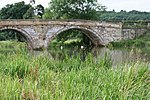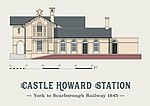Kirkham Abbey railway station
Disused railway stations in North YorkshireFormer York and North Midland Railway stationsGeorge Townsend Andrews railway stationsPages with no open date in Infobox stationRailway stations in Great Britain closed in 1930 ... and 3 more
Railway stations in Great Britain opened in 1845Use British English from December 2016Yorkshire and the Humber railway station stubs

Kirkham Abbey railway station was a minor railway station serving the village of Kirkham in North Yorkshire, England on the York to Scarborough Line and was opened on 5 July 1845 by the York and North Midland Railway. It closed on 22 September 1930. The station was originally just named Kirkham, but the 'Abbey' suffix was added on 1 June 1875, to take into account the proximity of the ruins of Kirkham Priory.
Excerpt from the Wikipedia article Kirkham Abbey railway station (License: CC BY-SA 3.0, Authors, Images).Kirkham Abbey railway station
Onhams Lane,
Geographical coordinates (GPS) Address External links Nearby Places Show on map
Geographical coordinates (GPS)
| Latitude | Longitude |
|---|---|
| N 54.082395 ° | E -0.880813 ° |
Address
Kirkham Abbey
Onhams Lane
YO60 7JW
England, United Kingdom
Open on Google Maps










